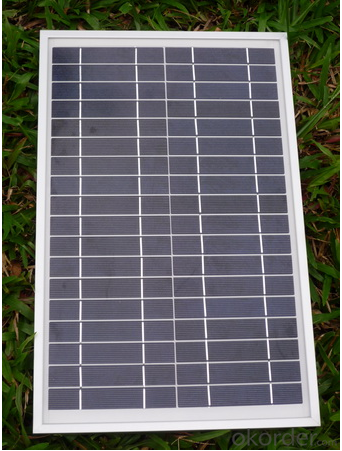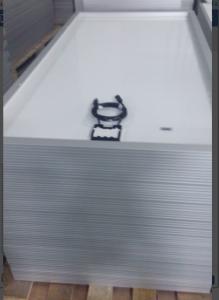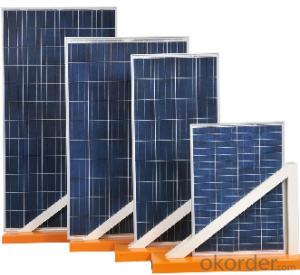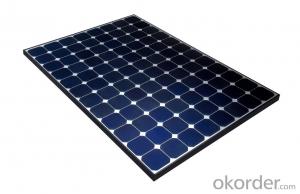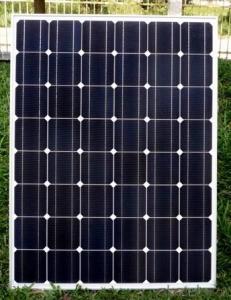Integrated CNBM Poly 150W Solar Panel with TUV UL CE Certificate for Residential
- Loading Port:
- China main port
- Payment Terms:
- TT OR LC
- Min Order Qty:
- 100 watt
- Supply Capability:
- 1000 watt/month
OKorder Service Pledge
OKorder Financial Service
You Might Also Like
Specification
CNBM Poly 150W Solar Panel with TUV UL CE Certificate For Residential
Introduction
This is a kit using for factory and storage field. This product is a higher output version with stable power and we guarantee you for 20years.

Suggested application
Home lighting business lighting,
Garden lighting, pavement lighting
Farmer household lighting
Decorative water pump
Traffic signal lighting
Industry area
Business area
Solar Power Plant
Product feature
Modules are made of Monocrystalline or Polycrystalline Silicon cell.
Materials and color of the solar panel frame: Clear anodized aluminum alloy type 6063T5 Universal frame; Silver-white color;
The output connection gathers the coupling: Selects conforms to the IEC-612615; 2005, class II, IEC61730 international standard; Airtight waterproofing binding clamp;
Module seal structure: The surface is thick, the high diaphanous rate armored glass with solar cell board special-purpose 3.2mm becomes after the high temperature lamination craft. The back selects has waterproof and anti- aged performance fine TPT materials. The entire block battery board has, the waterproofing, the anti- aging airtight and so on the fine performance;
Power tolerance: +/-3%
Packaging
International standard cartons (according to the requirements of customers)
- Q: For my Product Design Coursework I am designing an environment friendly building according to a clients' specifications. I need to find out the dimensions of 0000 watt solar panels. any help would be much appreciated!
- About 2500 Sq. Yd.s
- Q: what is needed beside the panels and do you need an electrician to hook it up
- The main components for a solar electric system are the panels, racks for mounting the panels, and inverter to convert the panel's DC power to AC, which can be pumped into the grid if necessary. There would also be various electrical supplies involved - wire, conduit, possibly a switch and/or circuit breaker. On the paperwork side, there's a building permit, permission from the power company to connect, and some inspections. Although it could be done by a homeowner, it's not a trivial project, and the best way to get it set up is to contract a professional solar installer. They all give free quotes, and can explain your various options when they visit.
- Q: I thought they were going to make solar powered cars and solar power plants among other things. It was only nearly 0 years ago that solar power was the big thing. Just curious, why did it die out?
- they still make them,i have them on my camper to charge the batteries, they are not cheap, however. you can get them at r.v. supply stores. in fact the ones they make now, are quite efficient, many people in the countryside use them for their homes, i dont know why the development for cars is so slow, though.
- Q: Can solar panels be used in cloudy regions?
- Yes, solar panels can still be used in cloudy regions. While solar panels do work best under direct sunlight, they can still generate electricity from diffused or scattered sunlight present in cloudy conditions. However, the overall energy output may be lower compared to sunny regions.
- Q: cheapest price for a 20 watt solar panel sold on line
- Expand your knowledge and learn from a renowned solar company about the Best and cheap Solar Panels. Visit our site and contact us today!
- Q: I need to know what the main components of a solar water heater and how they functionThanks if you answer x
- For vacuum tubes solar heaters the main component include: solar tank, vacuum tubes, solar frames, and the pipelines and fittings of whole system
- Q: I'm writing a lab and I have to put information about solar panels in it. The history, who started them, why they are useful etc. any good sites that can help me?
- I had solar panels installed in the beginning of the fall and I'm a big fan of them! I therefore know some info but I'm not sure if it would really be enough for you. Heres what I know: you save lots of money because you get federal tax credits and state rebates, and you help keep the environment green. The place that installed my solar panels has a lot of info that may be applicable to you, on their website or you can call them @ 866-276-7222 - they have great costumer service!
- Q: I got a really great deal on 2 houses because they were fixer-uppers. I'm living in one and the other I'm renting out. However, the previous owner did everything himself in 950 95, so needless to say, things are not to todays standards. Both houses need rewiring (there are no ceiling lights, few outlets, and mine has two old fuse boxes and the other has a breaker box but it pops the breaker a lot). The only reason they are still functional is because both houses use natural gas for water and heat, so otherwise, they electrical work is getting us by, but who knows for how long. I thought that maybe instead of redoing the electric, that I could just add solar panels to compensate for the small electric boxes. Also, since I would have to hire electricians to do all the work, which would be more cost effective (not including the decrease in utilities since I don't pay the utilities in the rental anyways)?
- If there is already electricity on the street, you won't save anything up-front by adding solar. In fact, it will cost a lot more. You'd still have to have them wired up to code, plus have inverters and maybe a kit to sell power back to the utility. It may pay for itself in 20 years if the price of electricity rises. Otherwise, solar makes sense if you are miles from town and the utility wants $00,000 to run a power line to your house. (My figures are total guesswork - check with a local solar installer or two)
- Q: Do solar panels require a backup battery system?
- No, solar panels do not necessarily require a backup battery system. It depends on the specific purpose and setup of the solar panel system.
Send your message to us
Integrated CNBM Poly 150W Solar Panel with TUV UL CE Certificate for Residential
- Loading Port:
- China main port
- Payment Terms:
- TT OR LC
- Min Order Qty:
- 100 watt
- Supply Capability:
- 1000 watt/month
OKorder Service Pledge
OKorder Financial Service
Similar products
Hot products
Hot Searches



